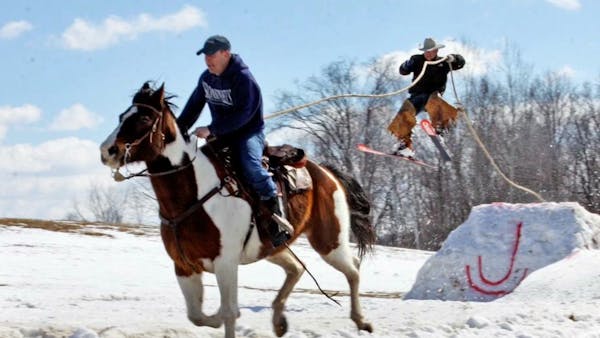Skijoring is derived from a Norwegian word that roughly translates as "ski driving," and the activity dates back to when both animals and skis were used as basic transportation.
For hundreds of years, Laplanders harnessed reindeer to pull people on skis, according to Skijor International. By the 19th century, horse-pulled skiers were delivering military dispatches in Nordic countries.
With its Scandinavian heritage, it's not surprising that equine skijoring once was a popular pastime in Minnesota. Old newspaper accounts report that horse skijorers raced at Lake Como in 1917 as part of the St. Paul Winter Carnival.
In 1928, skijoring made its sole appearance as a demonstration sport at the Winter Olympics, with a flat, frozen lake race in St. Moritz, Switzerland.
In the 1930s, people were skijoring behind horses on Lake of the Isles in Minneapolis, as part of a Carleton College winter sports carnival and by Breck students using the school's horses.
But by 1964, the Minneapolis Star reported that the practice of using horsepower to ski had all but disappeared in Minnesota, "apparently displaced by modern chair lifts, rope tows and other mechanical assists."
The sport seems to have moved out West, where, in the 1950s, cowboy skiers started skijoring after a guy in Leadville, Colo., bragged there wasn't a horse fast enough to lose him on a pair of skis, according to one history of the sport's "modern era."
The boast led to a race in Leadville (that's now held every year) on a snow-covered main street. From there, the sport spread to other Western states, New England, even Montreal.
Equine skijoring's return to Minnesota with Extreme Horse Skijoring at Canterbury Park will feature the modern, obstacle-course skijoring format used out West, with heats in novice, youth, snowboarding and open divisions.
Richard Chin
Want to see a video of a reporter giving it a try? Go to startribune.com/variety To see a dog-driven version of skijoring, go to http://strib.mn/2srXcDc
With 'Alien' back in theaters, 'Alien: Romulus' director teases how the new film connects
Ukrainian duo heads to the Eurovision Song Contest with a message: We're still here
Here's why Harvey Weinstein's New York rape conviction was tossed and what happens next

